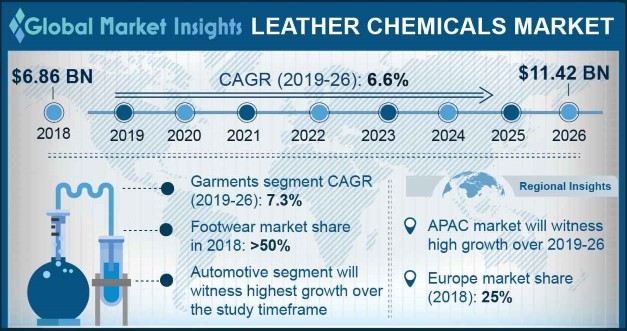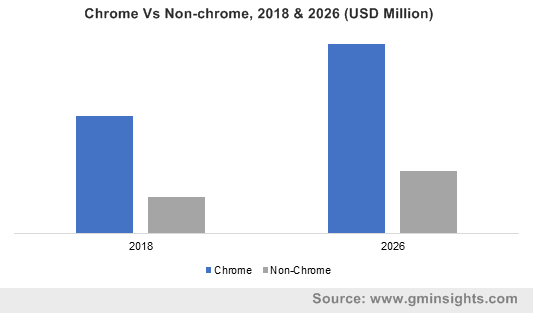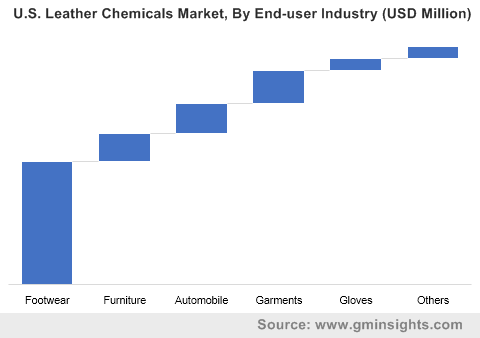Home > Chemicals & Materials > Specialty Chemicals > Custom Synthesis > Leather Chemicals Market
Leather Chemicals Market Size By Product (Beamhouse Chemicals [Soaking, Liming, Deliming & Bating], Tanning [Chrome, Non-chrome], Dyeing [Water-based, Non-water based], Finishing Chemicals [Polyurethane, Acrylic, Silicone]), By End-user Industry (Footwear, Furniture, Automobile, Garments, Gloves), Industry Analysis Report, Regional Outlook, Growth Potential, Price Trends, Competitive Market Share & Forecast, 2019 – 2026
- Report ID: GMI1526
- Published Date: Dec 2019
- Report Format: PDF
Leather Chemicals Market Size
Leather Chemicals Market size is estimated to exhibit over 6.6% CAGR by 2026, from USD 6.86 billion in 2018. Development in the automobile industry, rise in the adoption of high-end upholstery leather in luxury cars and rising penetration of luxury cars are expected to boost the growth of global market.

Leather chemicals form an important part in leather industry and are required to process raw animal hides to obtain finished products. These are used in the process ranging from tanning chemicals, dyeing, beamhouse, and finishing. It includes multiple chemicals acting as fundamental modifiers responsible for providing color, texture, smoothness, and pattern to the final products that are further used in manufacturing of footwear, apparels, furniture, auto upholstery, and garments.
| Report Attribute | Details |
|---|---|
| Base Year: | 2018 |
| Leather Chemicals Market Size in 2018: | 6.86 Billion (USD) |
| Forecast Period: | 2019 to 2026 |
| Forecast Period 2019 to 2026 CAGR: | 6.6% |
| 2026 Value Projection: | 11.42 Billion (USD) |
| Historical Data for: | 2015 to 2018 |
| No. of Pages: | 170 |
| Tables, Charts & Figures: | 206 |
| Segments covered: | Product, End-user Industry, Region |
| Growth Drivers: |
|
| Pitfalls & Challenges: |
|
Rapidly changing apparel trends owing to shift in consumer expectations and innovative production techniques is leading to fast fashion thereby driving the leather chemicals market expansion. Fast fashion comprises of trend replication, production and distribution at fast pace in response to the ongoing trends. This evolution in clothing and apparel manufacturing is providing the leather chemicals industry with opportunistic scenarios. The manufacturers are introducing more iterations for the consumers in less amount of time. It has dramatically increased demand for high quality and environmentally friendly processing chemicals.
Leather Chemicals Market Analysis

Non-chrome tanning chemicals and processes will witness strong growth in leather chemicals market, owing to increasing government regulations pertaining to potential releases to the environment. The manufacturers are embracing non-chrome metal tanning processes and are extending operations to support environmental cause. For instance, in September 2016, Kering, Yves Saint Laurent, Balenciaga and other luxury brands announced extension of metal-free tanning process to crocodilian skins. The chrome segment leads the leather chemicals industry size high degree of thermal resistance and superior appearance.
Silicon based leather chemicals is gaining traction owing to its compatibility with major class of organic and inorganic solvents. The silicon solution imparts durability, flexibility, abrasion resistance and water repellence. Leather finishing includes the utilization of series of coatings on the leather surface. These coatings are designed to protect leather, enhance aesthetics and comfort of the garments. Various mechanical operations are utilized to obtain the desired effect on the clothing. Hydraulic presses, vacuum driers, automatic spray applicators and embossing machines are some of the major machines used in the finishing process.

Garments segment will witness promising gains of 7.3% CAGR over the forecast timeframe, owing to an increase in adoption of leather attires as insulating and safety apparels. The leather garments have emerged as primary cold-weather outer-wear in regions experiencing extreme cold conditions. This is surging the clothing production and export across the globe. The demand for the products depends largely on consumers’ disposable income, urban population growth and willingness of consumer to spend money.
The automotive segment will witness highest growth over the leather chemicals market study during owing to rapid adoption of high-end upholstery leather in luxury cars. Rising penetration of luxury cars across the glove will positively influence the industry expansion. The automotive interior product suppliers are providing accessories with unique tan, texture and colors to attract consumers. Further, the introduction of corrected-grain leathers to match with other materials will enhance the segment penetration.

Asia Pacific leads the leather chemicals market share owing to presence of multiple leather processing units and tanneries. The region is witnessing continuous shift of processing units with the availability of cost-competitive labor, land, and raw material. For instance, in May 2018, Creative Performance Leather announced an investment of over USD 3.5 Million for production line in Samutprakarn Province, Bangkok. Substantial leather production in India and China coupled with increasing customer base for leather products is propelling the demand for leather chemicals.
In 2018, Europe accounted for around 25% share the in the leather chemicals market growth owing to increasing exports. Presence of small to medium scale tanneries are major contributor in boosting countries regional and international exports. Countries including Italy and France are amongst the largest producer of bovine leather and are popular for renowned and meticulous leather manufacturing and tanning techniques. Europe retains a considerable proportion of chemical manufacturers and has a sizeable automobile industry that further compliments the industry expansion.
Leather Chemicals Market Share
Leather chemicals market players are engaged in gaining strategic long-term contracts and agreements to strengthen their market share. For instance, in August 2019, Brother’s enterprises of China announced acquisition of LANXESS’s Chrome chemical business. Further, in October 2017 Stahl group announced acquisition of BASF’s leather chemical business.
Some service providers are incorporating research to provide sustainability in leather tanning process. For instance, in 2014, Lanxess announced new line of water based pigment solution X-pigment for leather finishing. This chemical feature improved light fastness, migration resistance, and exact dosing properties.
Leading market players analyzed in the research include:
- Elementis
- Clariant
- Dupont
- Eastman Chemical Company
- Solvay
- Evonik Industries
- Arkema
- SABIC.
The report also analyzes key strategies adopted by them including mergers & acquisitions, partnerships, collaborations, and others to gain strong position in the leather chemicals market.
The leather chemicals market research report includes in-depth coverage of the industry with estimates & forecast in terms of volume in kilo tons and revenue in USD billion from 2015 to 2026, for the following segments:
Click here to Buy Section of this Report
By Product
- Tanning
- Chrome
- Non-chrome
- Dyeing
- Water soluble
- Non-water soluble
- Beamhouse Chemicals
- Soaking
- Liming
- Deliming & Bating
- Finishing Chemicals
- Polyurethane
- Acrylic
- Silicone
- Others
By End-user Industry
- Footwear
- Furniture
- Automobile
- Garments
- Gloves
- Others
The above information is provided on a regional and country basis for the following:
By Region
- North America
- U.S.
- Canada
- Europe
- Germany
- UK
- France
- Italy
- Spain
- Russia
- Asia Pacific
- China
- India
- South Korea
- Thailand
- Latin America
- Brazil
- Mexico
- Argentina
- Middle East & Africa
- Egypt
- Turkey
- South Africa
